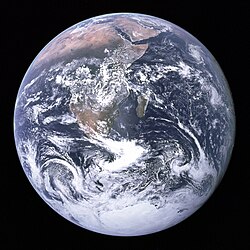(also at Daily Kos)
Every so often, people argue that global warming and other possible climate change can’t be a big deal because it’s “only 1 degree” or so, every few decades. After all, if you step outside and it’s 1 degree warmer than yesterday, you can hardly feel it. And two nearby cities — even two different neighborhoods in the same city — can easily have average temperatures differing by just 1 degree. So obviously “only 1 degree” is pretty trivial, right?
Au contraire. One degree is a lot, especially under the right circumstances. How much is “a lot”? More below.
Advance warning: high-school-science class level math ahead. I can’t make the point without it.
Let’s look at this thing for a moment:

About 70% of its surface is covered with water. If you warm all that water up by 1 degree, how much energy is that?
Counting Calories
Let’s take a look at the ocean. When the Earth gets hotter overall, the heat enters a fairly thin layer — perhaps 10 to 100 meters. Let’s call it 10, to keep things simple. This is about 33 feet, and is the part of the Earth’s oceans and lakes that will warm up the most.
The surface area of the Earth’s bodies of water is 361,220,420 square kilometers. Since we’re looking at a 10-meter (0.01 kilometer) layer of water here, the amount of water being heated up is (361,220,420) x (0.01) = 3,612,204 cubic kilometers.
Since we’re warming water up, let’s look at an energy unit that’s very appropriate for measuring precisely that. You may recall from science class that a calorie is the amount of energy required to warm 1 gram of water 1 tiny, irrelevant degree Celsius — the same as 1.8 degrees Fahrenheit. One cubic kilometer of water weighs about one thousand trillion grams (1015 grams, if you like). Our 10-meter layer of the Earth’s water is 3,612,204 cubic kilometers, so to heat that layer 1 trivial, insignificant degree Celsius, you need:
1015 grams per cubic km x 3,612,204 cubic km x 1 degree per calorie
which is 3.61 x 1021 calories.
Pretty big number. In fact, if you counted all the molecules in a drop of water, you’d end up with about that number by the time you counted every last molecule in the drop. But of course, the Earth is huge, as well. So how does this compare to something more tangible, like the amount of energy we actually use?
Watt’s up with that?
When you get your electric bill, you probably see how many kilowatt-hours you’ve used. This is just a measure of electrical power (watts) over a given amount of time. It turns out that this is really a measure of total energy — the form doesn’t matter. Same thing with calories. You can interconvert the two:
1 kilowatt hour = 860420 calories
which means that one stupid, silly degree has given us this much energy in kilowatt-hours:
3.61 x 1021 calories / 860,420 = 4.19 x 1015 kilowatt-hours.
A typical household in the U.S. uses about 600 kilowatt-hours of electricity per month. This is 7200 kilowatt-hours per year, or about 3000 kilowatt-hours per person, assuming a household average size of about 2.5 people. Since there are about 300 million people in the U.S., we use approximately
300 x 106 people x 3000 per person = 9 x 1011 kilowatt hours per year.
This is just short of a trillion kilowatt hours per year.
Of course, this is just residential electricity usage. Judging from this table, in 1998, 9.8 % of the U.S.’s energy came from nuclear power, which produced 673.7 billion kilowatt hours. Converting all the other energy sources to the same units, the entire energy output of the U.S. is a little over 10 times that, or 6.874 trillion kilowatt hours to be precise.
Well, remember that we just figured that one foolish, insensible degree put 4.19 x 1015kilowatt hours into the oceans and lakes of the world. That’s 4190 trillion kilowatt hours. In other words, one silly, stupid degree equals six hundred years of the U.S.’s annual energy consumption, and more than four thousand times the U.S.’s annual electricity use by people at their homes.
Among other things, this energy can fuel things like these critters, which run primarily off the thermal energy in the upper layers of the ocean, and for which 1 degree can mean a big difference in intensity. It can also melt huge amounts of these features, even when the water itself is just 1 degree above freezing.
Anyone still think that one degree is tiny?




